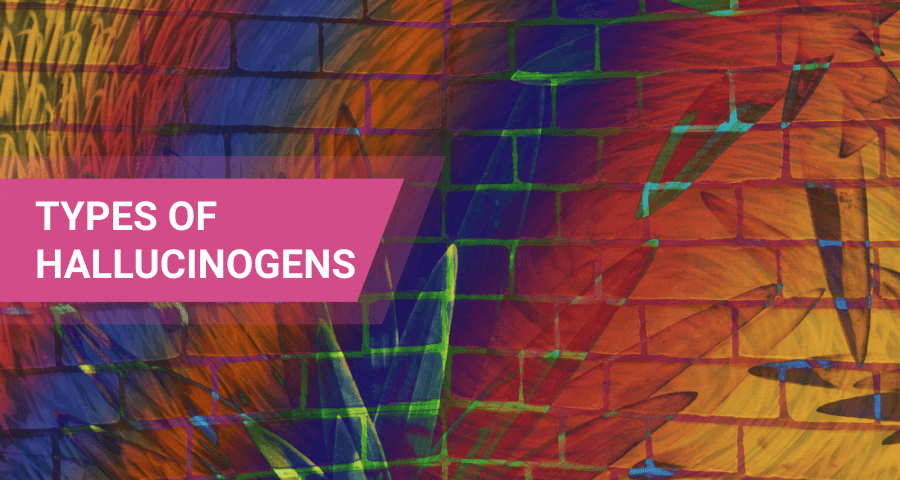
There are man-made, as well as derived from mushrooms and plants types of hallucinogens. Depending on their mechanism of action, there are three different types of hallucinogens, psychedelics, dissociatives, and deliriants. They all generally have the same effects of altering a person’s awareness of the surroundings, feelings, and thoughts.
Learn About Hallucinogens Types:
Common Hallucinogens Types
Psychedelics
The primary action of psychedelic hallucinogens is to amplify or enhance the brain’s thought processes of disabling the filters that block undesired signals from reaching the conscious mind, such as memories, emotions and the subconscious mind. It is known as ‘consciousness expanding,’ a process through which the conscious is assaulted by things that are usually inaccessible to it. At some point, this process can become overwhelming, inducing a dissociative state. Many are aware of the short term effects of hallucinogens but have no idea about the dangers they can cause in the long run.
Some of the most known examples of psychedelics are:
- LSD (Lysergic Acid Diethylamide) is made from a substance extracted from the ergot fungus. It is a controlled substance. This serotonergic hallucinogen transforms perception and induces visual hallucinations, but also panic attacks, paranoia, anxiety, and suicidal ideation.
- Psilocybin is a substance found in certain mushrooms. Its legal status is ambiguous as the mushrooms grow widely in various parts of the world.
- DMT (Dimethyltryptamine) has a similar structure to psilocin. It can also be made in the laboratory. This type of hallucinogens is very potent, causing euphoric states but also possibly damage to physical and mental health.
- Mescaline is made from the Mexican peyote combined with the San Pedro cactus. It has similar side effects to LSD. In the US its is a federally controlled Schedule I substance, but the American Indian Religious Freedom Act allows the members of the Native American Church to use it.
- 2C-B (4-Bromo-2,5-dimethoxyphenethylamine) is a synthesized drug belonging to the phenethylamine family. In the US, it is a Schedule I substance.
- DOM (2,5-Dimethoxy-4-methylamphetamine) is part of the DOx family of compounds. It is a substituted amphetamine and psychedelic and a Schedule I substance in the US.

Dissociatives
Dissociative hallucinogens give a feeling of depersonalization, a form of sensory deprivation, making the individuals feel outside their bodies, allowing the mind to create its own perceptions and environment. It is achieved by blocking the signals sent by other parts of the brain to the conscious mind. This process facilitates hallucinations, self-exploration, and dreamlike or psychedelic states.
Here is a list of hallucinogens that enter into this dissociatives category:
- Ketamine is an anesthetic used in surgery, and much of the drug found on the streets has its source in veterinary offices. In the US, it is a Schedule III non-narcotic substance.
- PCP (Phencyclidine) was used as a surgical anesthetic. Today, this type of hallucinogens is a Schedule II substance in the US. PCP is a dissociative drug that causes loss of coordination, blank stare, amnesia, and paranoia, among others.
- DXM (Dextromethorphan) is used in cough syrups and medicines due to its mucus-clearing and suppressant properties.

Deliriants
Unlike psychedelics and dissociatives, deliriant hallucinogens are antagonists for the acetylcholine receptors. These are seen as the real hallucinogens, and they can create a false perception with no basis whatsoever in the individual’s external and internal reality. Users often have conversations with people that are not there, lucid dreams, and are not be able to recognize their own reflection in a mirror.
This type of hallucinogens can cause a user to enter a state of confusion and stupor. Used in excess, they can induce vivid, unpleasant hallucinations, and even cause death in case of overdose. That is why these drugs are not very popular.
Common examples of deliriant type of hallucinogens:
- Datura contains certain types of alkaloids, such as atropine, hyoscyamine, and scopolamine, and it is one of the most abused recreational drugs. Abusing Datura can cause hallucinations, mood disorders, unusual behavior, overdose, and even death.
- Deadly Nightshade (Atropa belladonna) is another of the hallucinogens types. Eating ten to twenty berries of the plant can instantly kill an adult. Even in small amounts, it can cause hallucinations, delirium, headache, convulsions, and even loss of consciousness.
- Jimson Weed (Datura stramonium or Thornapple) is quite poisonous, and in high doses, the plant can cause unconsciousness, insanity, and even death. Some people can get stuck in what is called a thornapple journey, leaving them insane for a long time.
Recreational use of drugs, including hallucinogens types, is considered as abuse and is illegal. Abuse may result in addiction, which requires treatment in rehab facilities.
Synthetic Hallucinogens
Synthetic hallucinogens are the most common hallucinogens and are made in the laboratory, derived from phenethylamine. The effects are similar to those of natural hallucinogens.
Over the past years, there has been a rapid increase in the availability and use of synthetic hallucinogens, leading to an unprecedented challenge when it comes to drug addiction.
Examples of hallucinogens in this category include:
- PMA/PMMA is a type of drug similar to Ecstasy or meth. It can cause increased body temperature, heart rate, hallucinations, respiratory distress, and convulsions. The drug is associated with dozens of deaths.
- Mephedrone belongs to the cathinone class, and it is similar to amphetamine in structure. The drug has also been associated with several deaths.
- MDPV (3,4 methylenedioxypyrovalerone) is another type of cathinone drug, similar to mephedrone but with much more potent effects compared to other drugs in its class.
- bk-MDMA (methylone) is a very dangerous drug-associated with sudden deaths. This type of synthetic hallucinogens is frequently found in bath salts and Ecstasy pills.
- Bromo-DragonFLY is an extremely potent type of psychoactive benzodifuran. Its effects are lower in intensity compared to LSD but last much longer.
- NBOMes (25B-NBOMe, 25C-NBOMe, and 25I-NBOMe) are synthetic hallucinogens of Schedule I in the US. They have similar effects to LSD, but some of them have an increased risk of harm.

Herbal Hallucinogens
There are some types of plants that produce a variety of chemical compounds, making them plant-based hallucinogens. These secondary metabolites serve as a protective mechanism for plants. However, when these chemicals enter the human body, they cause numerous side effects. These herbal hallucinogens can be found around the world.
Herbal hallucinogens examples:
- Peyote (contains mescaline): is a renowned potent psychedelic cactus and one of the most powerful hallucinogens
- Salvia (contains salvinorin A): can produce a hallucinatory, manic state, and a person might laugh without reason and run uncontrollably.
- Ayahuasca (contains DMT and MAOI): mainly used for religious purposes.
- Virola (contains 5-MeO-DMT and DMT): has strong hallucinogenic properties.
- Hawaiian baby woodrose (contains Ergine): mainly used for psychedelic and spiritual experiences.
- Turbina corymbosa (contains Ergine): produces a state of inebriation and relaxation, which are close to LSD but much weaker.
- Badoh Negro (contains Ergine): traditionally used in divination by Aztecs, in a potion with strong analgesic properties.
- Iboga (contains ibogaine): stimulates the central nervous system inducing hallucinations.
- Cannabis sativa (contains THC): produces mind-altering effects.
- Peruvian Torch cactus (contains mescaline): is consumed as a tea during collective ceremonies to induce the feeling of being one with mother nature.
- San Pedro cactus (contains mescaline): is used in Peru in cleansing ceremonies and to enliven the body, mind, and spirit.
- Henbane (contains tropane alkaloids): used in traditional herbal medicine but also as a sedative, analgesic, and narcotic in some cultures.
- Mandrake (contains tropane alkaloids): used in magic rituals and in contemporary pagan traditions to worship the deities and working magic.
If hallucinogen refers to a natural type, it does not mean that it’s safe. Most herbal hallucinogens are banned in the US as their use cause detrimental side effects, including death.
The Risk Of Hallucinogens
Even herbal hallucinogens can become very dangerous if abused. A hallucinogen overdose can result in life-threatening symptoms or even death. Hopefully, there are numerous drug rehab centers that can offer specialized help for those who have developed hallucinogens withdrawal. The safest way to ease these side effects is to address them under close doctor’s supervision.
Page Sources
- Nicol JJ, Yarema MC, Jones GR, et al. Deaths from exposure to paramethoxymethamphetamine in Alberta and British Columbia, Canada: a case series. Canadian Medical Association Journal. 2015; 3(1): E83–E90. Published 2015 Jan 13. doi:10.9778/cmajo.20140070. https://www.ncbi.nlm.nih.gov/pmc/articles/PMC4382046/.
- Fantegrossi WE, Murnane KS, Reissig CJ. The behavioral pharmacology of hallucinogens. Biochemical Pharmacology. 2008; 75(1): 17–33. doi:10.1016/j.bcp.2007.07.018. https://www.ncbi.nlm.nih.gov/pmc/articles/PMC2247373/.


 Reviewed by:
Reviewed by:  Written by:
Written by: 


 FindTreatment.gov
FindTreatment.gov